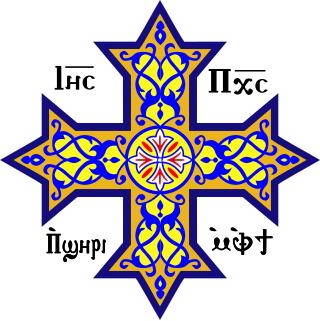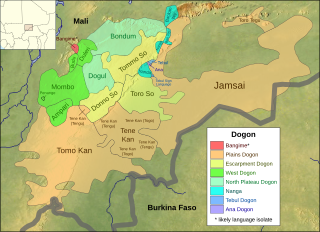Related Research Articles
In grammar, the comitative case is a grammatical case that denotes accompaniment. In English, the preposition "with", in the sense of "in company with" or "together with", plays a substantially similar role.

Coptic is a group of closely related Egyptian dialects, representing the most recent developments of the Egyptian language, and historically spoken by the Copts, starting from the third century AD in Roman Egypt. Coptic was supplanted by Arabic as the primary spoken language of Egypt following the Arab conquest of Egypt and was slowly replaced over the centuries. Coptic has no native speakers today, although it remains in daily use as the liturgical language of the Coptic Orthodox Church and of the Coptic Catholic Church. Innovations in grammar and phonology and the influx of Greek loanwords distinguish Coptic from earlier periods of the Egyptian language. It is written with the Coptic alphabet, a modified form of the Greek alphabet with several additional letters borrowed from the Demotic Egyptian script.
Rapa Nui or Rapanui, also known as Pascuan or Pascuense, is an Eastern Polynesian language of the Austronesian language family. It is spoken on Easter Island, also known as Rapa Nui.
Rapa is the language of Rapa Iti, in the Austral Islands of French Polynesia, and of Mangaia in the Cook Islands. It is an Eastern Polynesian language. There are three varieties of the Rapa language currently being spoken in French Polynesia: Old Rapa, Reo Rapa and New Rapa. Old Rapa has been mostly replaced by Reo Rapa, a mix of the more commonly spoken Tahitian and Old Rapa. New Rapa – revitalized Old Rapa – is commonly spoken by middle-aged and younger speakers. Rapa is a critically endangered language, and there are only around 300 speakers of Reo Rapa, with only 15% of them able to speak Old Rapa. It may be more vibrant on Mangaia, but there the population has been declining for half a century due to emigration.
Vaeakau-Taumako is a Polynesian language spoken in some of the Reef Islands as well as in the Taumako Islands in the Temotu province of Solomon Islands.

The Plains Apache language was a Southern Athabaskan language formerly spoken by the Plains Apache, organized as the Apache Tribe of Oklahoma, living primarily around Anadarko in southwest Oklahoma. The language is extinct as of 2008, when Alfred Chalepah, Jr., the last native speaker, died.
In linguistics, a complementizer or complementiser is a functional category that includes those words that can be used to turn a clause into the subject or object of a sentence. For example, the word that may be called a complementizer in English sentences like Mary believes that it is raining. The concept of complementizers is specific to certain modern grammatical theories. In traditional grammar, such words are normally considered conjunctions. The standard abbreviation for complementizer is C.
Kadiwéu is a Guaicuruan language spoken by the Kadiweu people of Brazil, and historically by other Mbayá groups. It has around 1,200-1,800 people in Brazil. It is mainly a subject–verb–object language.
Manam is a Kairiru–Manam language spoken mainly on the volcanic Manam Island, northeast of New Guinea.

East Ambae is an Oceanic language spoken on Ambae, Vanuatu. The data in this article will concern itself with the Lolovoli dialect of the North-East Ambae language.
Apurinã, or Ipurina, is a Southern Maipurean language spoken by the Apurinã people of the Amazon basin. It has an active–stative syntax. Apurinã is a Portuguese word used to describe the Popikariwakori people and their language. Apurinã indigenous communities are predominantly found along the Purus River, in the Northwestern Amazon region in Brazil, in the Amazonas state. Its population is currently spread over twenty-seven different indigenous lands along the Purus River. with an estimated total population of 9,500 people. It is predicted, however, that fewer than 30% of the Apurinã population can speak the language fluently. A definite number of speakers cannot be firmly determined because of the regional scattered presence of its people. The spread of Apurinã speakers to different regions was initially caused by conflict or disease, which has consequently led natives to lose the ability to speak the language for lack of practice and also because of interactions with other communities.
In linguistics, coordination is a complex syntactic structure that links together two or more elements; these elements are called conjuncts or conjoins. The presence of coordination is often signaled by the appearance of a coordinator, e.g. and, or, but. The totality of coordinator(s) and conjuncts forming an instance of coordination is called a coordinate structure. The unique properties of coordinate structures have motivated theoretical syntax to draw a broad distinction between coordination and subordination. It is also one of the many constituency tests in linguistics. Coordination is one of the most studied fields in theoretical syntax, but despite decades of intensive examination, theoretical accounts differ significantly and there is no consensus on the best analysis.

Bangime is a language isolate spoken by 3,500 ethnic Dogon in seven villages in southern Mali, who call themselves the bàŋɡá–ndɛ̀. Bangande is the name of the ethnicity of this community and their population grows at a rate of 2.5% per year. The Bangande consider themselves to be Dogon, but other Dogon people insist they are not. Bangime is an endangered language classified as 6a - Vigorous by Ethnologue. Long known to be highly divergent from the (other) Dogon languages, it was first proposed as a possible isolate by Blench (2005). Heath and Hantgan have hypothesized that the cliffs surrounding the Bangande valley provided isolation of the language as well as safety for Bangande people. Even though Bangime is not closely related to Dogon languages, the Bangande still consider their language to be Dogon. Hantgan and List report that Bangime speakers seem unaware that it is not mutually intelligible with any Dogon language.
Abui is a non-Austronesian language of the Alor Archipelago. It is spoken in the central part of Alor Island in Eastern Indonesia, East Nusa Tenggara (NTT) province by the Abui people. The native name in the Takalelang dialect is Abui tanga which literally translates as 'mountain language'.
The Timor–Alor–Pantar (TAP) languages are a family of languages spoken in Timor, Kisar, and the Alor archipelago in Southern Indonesia. It is the westernmost Papuan language family, and one of two such outlier families in east Nusantara.
Mingrelian is a Kartvelian language that is mainly spoken in the Western Georgian regions Samegrelo and Abkhazia. In Abkhazia the number of Mingrelian speakers declined dramatically in the 1990s as a result of heavy ethnic cleansing of ethnic Georgians, the overwhelming majority of which were Mingrelians.

Yolmo (Hyolmo) or Helambu Sherpa, is a Tibeto-Burman language of the Hyolmo people of Nepal. Yolmo is spoken predominantly in the Helambu and Melamchi valleys in northern Nuwakot District and northwestern Sindhupalchowk District. Dialects are also spoken by smaller populations in Lamjung District and Ilam District and also in Ramecchap District. It is very similar to Kyirong Tibetan and less similar to Standard Tibetan and Sherpa. There are approximately 10,000 Yolmo speakers, although some dialects have larger populations than others.
Ledo Kaili is the largest member of the Kaili languages, which are a dialect chain within the Kaili–Pamona language family. These languages are spoken in Central Sulawesi (Indonesia). Kaili with all of its dialects is one of the largest languages in Sulawesi. One third of the population of Sulawesi Tengah province were (1979) native speakers of a Kaili language. The object language of this article is the main dialect Ledo, which is spoken in the Donggala and Sigi districts (Kabupaten) in and around the provincial capital Palu.
Kelon, or Klon, is a Papuan language of the western tip of Alor Island in the Alor archipelago of East Nusa Tenggara, Indonesia.
Lengo or informally known as doku is a Southeast Solomonic language of Guadalcanal and is closely related to Gela language.
References
- ↑ "UNESCO Atlas of the World's Languages in danger". www.unesco.org. Retrieved 2018-06-06.
- 1 2 3 4 5 6 7 8 Schapper, Antoinette (2014). "Kamang". In Schapper, Antoinette (ed.). The Papuan Languages of Timor, Alor and Pantar: Volume 1: Sketch Grammars. Walter de Gruyter. pp. 287–349.
- ↑ Grimes, Charles (1997). A guide to the people and languages of Nusa Tenggara (PDF). Kupang: Artha Wacana Press.
- ↑ Stokhof, W.A.L. (1979). Woisika II Phonemics (PDF). Australian National University.
- ↑ Stokhof, W.A.L. (1982). Woisika Riddles (PDF). Australian National University.